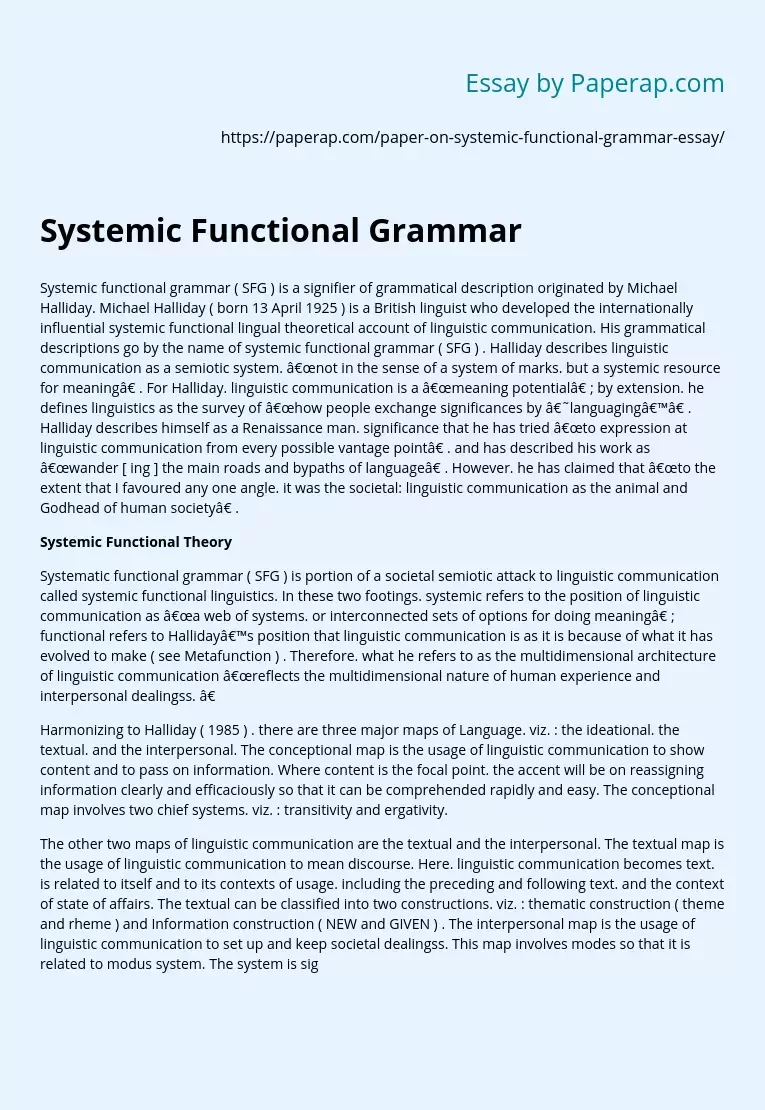Systemic Functional Grammar
Systemic functional grammar ( SFG ) is a signifier of grammatical description originated by Michael Halliday. Michael Halliday ( born 13 April 1925 ) is a British linguist who developed the internationally influential systemic functional lingual theoretical account of linguistic communication. His grammatical descriptions go by the name of systemic functional grammar ( SFG ) . Halliday describes linguistic communication as a semiotic system. “not in the sense of a system of marks. but a systemic resource for meaning” . For Halliday. linguistic communication is a “meaning potential” ; by extension. he defines linguistics as the survey of “how people exchange significances by ‘languaging’” .
Halliday describes himself as a Renaissance man. significance that he has tried “to expression at linguistic communication from every possible vantage point” . and has described his work as “wander [ ing ] the main roads and bypaths of language” . However. he has claimed that “to the extent that I favoured any one angle. it was the societal: linguistic communication as the animal and Godhead of human society” .
Systemic Functional Theory
Systematic functional grammar ( SFG ) is portion of a societal semiotic attack to linguistic communication called systemic functional linguistics.
In these two footings. systemic refers to the position of linguistic communication as “a web of systems. or interconnected sets of options for doing meaning” ; functional refers to Halliday’s position that linguistic communication is as it is because of what it has evolved to make ( see Metafunction ) . Therefore. what he refers to as the multidimensional architecture of linguistic communication “reflects the multidimensional nature of human experience and interpersonal dealingss. ”
Harmonizing to Halliday ( 1985 ) .
there are three major maps of Language. viz. : the ideational. the textual. and the interpersonal. The conceptional map is the usage of linguistic communication to show content and to pass on information. Where content is the focal point. the accent will be on reassigning information clearly and efficaciously so that it can be comprehended rapidly and easy. The conceptional map involves two chief systems. viz. : transitivity and ergativity.
The other two maps of linguistic communication are the textual and the interpersonal. The textual map is the usage of linguistic communication to mean discourse. Here. linguistic communication becomes text. is related to itself and to its contexts of usage. including the preceding and following text. and the context of state of affairs. The textual can be classified into two constructions. viz. : thematic construction ( theme and rheme ) and Information construction ( NEW and GIVEN ) . The interpersonal map is the usage of linguistic communication to set up and keep societal dealingss. This map involves modes so that it is related to modus system. The system is signified by two chief elements. viz. : temper and residue.
In this paper. nevertheless the authors will analyse about the transitivity. so merely about the transitivity that can be explained more item. Traditionally. transitivity is usually understood as the grammatical characteristic. which indicates if a verb takes a direct object ; and we know some of the footings: a. If the verb takes a direct object. so it is described as transitive. and B. It is called intransitive if it does non ; c. An extension of this construct is the ditransitive verb. which takes both a direct and an indirect object. .
Halliday. nevertheless. found the new construct of transitivity. The new construct represents a farther development of the old construct. In Halliday’s construct in his Introduction to Functional Grammar. whether a verb takes or does non take a direct object is non a premier consideration. There are three constituents of what Halliday calls a “transitivity process” . viz. : a. The procedure itself. B. Participants in the procedure ; c. Fortunes associated with the procedure Then. Halliday divides the system of transitivity or procedure types into six procedures. viz. : stuff. mental. relational. behavioural. verbal. and experiential.
One distinguishable facet of Systemic Functional Linguistics ( SFL ) is the analysis of clauses in footings of procedure types. Harmonizing to the theory. the grammar provides a figure of scheme for boxing information into a clause. For case. material clauses consist of an Actor. a Procedure and a Goal. while mental clauses contain a Sensor. a Procedure and a Phenomenon. Each of these schemas corresponds to a procedure type.
Normally. six procedure types are identified: stuff. behavioral. verbal. mental. relational and experiential. Process type analysis was first described in Halliday ( 1976 ) . which stemmed from Halliday’s effort to develop the sort of grammar. which would back up instructors in learning linguistic communication. A Fuller. more evolved description was given in Introduction to Functional Grammar ( Halliday 1985. henceforth IFG ) . and its two ulterior editions. However. these texts proved excessively proficient for novices. and easier debuts were introduced.
Harmonizing to Halliday ( 1985 ) . if we talk about grammar in English. there are three sorts of grammar. viz. : ‘theme is the grammar of discourse’ . and ‘mood is the grammar of address function’ . so ‘transitivity is the grammar of experience. ’ Halliday ( 1981 ) besides defines transitivity as ‘the grammar of the clause’ as ‘a structural unit’ for ‘expressing a peculiar scope of conceptional meanings’ . In the transitivity system. there are six types of procedure. viz. : stuff. mental. relational. verbal. experiential. and behavioural.
Systemic Functional Grammar. (2019, Dec 05). Retrieved from https://paperap.com/paper-on-systemic-functional-grammar-essay/

